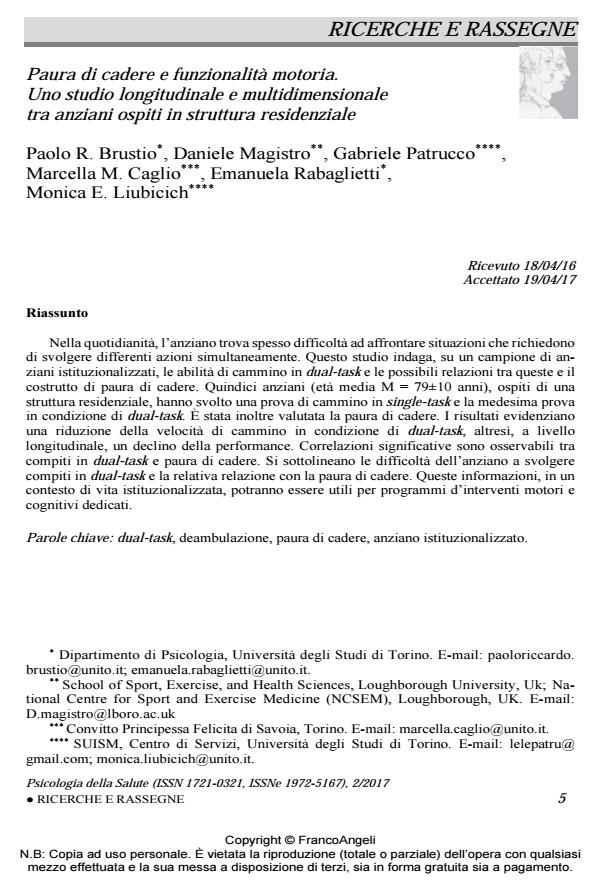Paura di cadere e funzionalità motoria. Uno studio longitudinale e multidimensionale tra anziani ospiti in struttura residenziale
Titolo Rivista PSICOLOGIA DELLA SALUTE
Autori/Curatori Paolo R. Brustio, Daniele Magistro, Gabriele Patrucco, Marcella M. Caglio, Emanuela Rabaglietti, Monica E. Liubicich
Anno di pubblicazione 2017 Fascicolo 2017/2
Lingua Italiano Numero pagine 16 P. 5-20 Dimensione file 235 KB
DOI 10.3280/PDS2017-002001
Il DOI è il codice a barre della proprietà intellettuale: per saperne di più
clicca qui
Qui sotto puoi vedere in anteprima la prima pagina di questo articolo.
Se questo articolo ti interessa, lo puoi acquistare (e scaricare in formato pdf) seguendo le facili indicazioni per acquistare il download credit. Acquista Download Credits per scaricare questo Articolo in formato PDF

FrancoAngeli è membro della Publishers International Linking Association, Inc (PILA)associazione indipendente e non profit per facilitare (attraverso i servizi tecnologici implementati da CrossRef.org) l’accesso degli studiosi ai contenuti digitali nelle pubblicazioni professionali e scientifiche
Nella quotidianità, l’anziano trova spesso difficoltà ad affrontare situazioni che richiedono di svolgere differenti azioni simultaneamente. Questo studio indaga, su un campione di anziani istituzionalizzati, le abilità di cammino in dual-task e le possibili relazioni tra queste e il costrutto di paura di cadere. Quindici anziani (età media M = 79±10 anni), ospiti di una struttura residenziale, hanno svolto una prova di cammino in single-task e la medesima prova in condizione di dual-task. È stata inoltre valutata la paura di cadere. I risultati evidenziano una riduzione della velocità di cammino in condizione di dual-task, altresì, a livello longitudinale, un declino della performance. Correlazioni significative sono osservabili tra compiti in dual-task e paura di cadere. Si sottolineano le difficoltà dell’anziano a svolgere compiti in dual-task e la relativa relazione con la paura di cadere. Queste informazioni, in un contesto di vita istituzionalizzata, potranno essere utili per programmi d’interventi motori e cognitivi dedicati.
Parole chiave:Dual-task, deambulazione, paura di cadere, anziano istituzionalizzato.
Paolo R. Brustio, Daniele Magistro, Gabriele Patrucco, Marcella M. Caglio, Emanuela Rabaglietti, Monica E. Liubicich, Paura di cadere e funzionalità motoria. Uno studio longitudinale e multidimensionale tra anziani ospiti in struttura residenziale in "PSICOLOGIA DELLA SALUTE" 2/2017, pp 5-20, DOI: 10.3280/PDS2017-002001